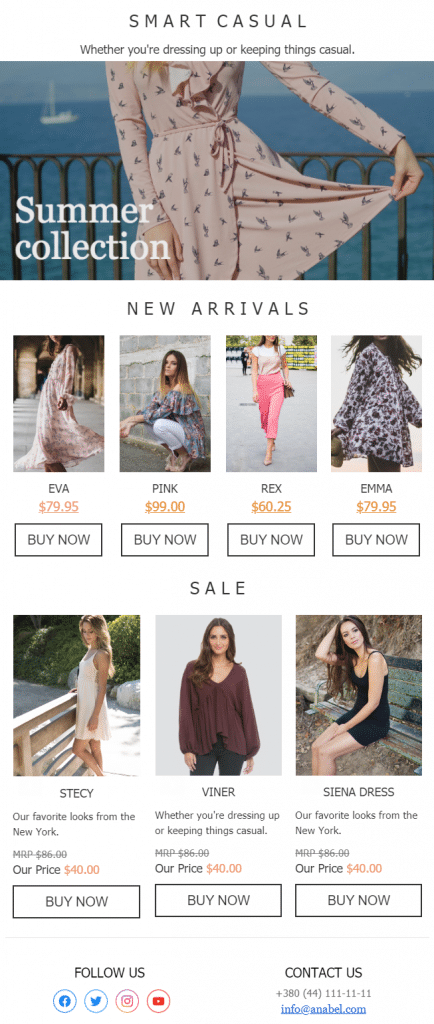Today, everyone is talking about Artificial Intelligence (AI) in marketing, using all-powerful machine algorithms for total personalization of campaigns. However, few know exactly this technology works and how it can be applied to email marketing.
Yes, AI helps achieve personalization, but does it on a deeper level than regular tools. Many think that email personalization starts and ends with addressing a person by a name in an email message. However, “Dear Tom” isn’t the most complex text that email personalization is capable of.
Using extensive customer data (personal info, website behavior, shopping history, or marketing campaign activity), algorithms can adjust any campaign to a particular recipient, using the following functions:
- optimize content display hierarchy;
- optimize send time;
- optimize annoyance level;
- build unique segments;
- create personalized product recommendations.
Each function has its own peculiarities and, requires a separate article to discuss. Here, we’ll talk in more detail about AI-supported email recommendations, and how they can help improve your click rate.
What Are Product Recommendations in Email?
Product recommendations are a separate block within an email that contains recommended products that are relevant to the recipient in terms of the given campaign and offer. There are bulk and personalized recommendations.
For customers without much existing data (new subscribers that haven’t yet bought from you), your campaigns would include standard recommendations that are similar for all recipients. Most often, such blocks are called Popular, Bestsellers, New Arrivals, Sales, or Staff Choice. Bulk recommendations are typical of promotional campaigns that introduce new collections and collaborations, or promote sales.

However, the more customer data you have, the more personalized your recommendations can be. Modern technologies, AI marketing analytics in particular, allow you to tailor these to each recipient. Examples of these blocks are Also Bought, You May Also Like, Recommended for You, Complement Your Look – algorithms assign items to these blocks based on the customer’s website behavior and preferences.

Personalized recommendations are typical of triggered campaigns – abandoned browses, abandoned carts, reactivations, confirmations – that are sent in response to customer’s activity or inactivity. In one email, there may be several blocks with different recommendation types that meet different goals.
What Data Is Used for Recommendations?
You can track any visitor activity on the website (via web tracking, API or an AI chatbot), and in emails and social media, then use the corresponding data to build accurate recommendations. This data may include:
- viewed pages, categories, products;
- frequently viewed brands;
- price;
- items added to cart;
- purchases;
- complementary products;
- bot requests;
- email clicks;
- likes, shares, and comments on corporate social media pages.
Advantages of Personalized Email Recommendations
One block definitely won’t make your click rate soar. But when combined with other elements that are well-designed and optimized (subject line, preheader, image, content localization, working links, no typos, understandable CTAs, clear design, modern color palette, etc.), AI-supported recommendations can contribute significantly to the overall effectiveness of a campaign.
Increased session depth and duration. It’s not rocket science to conclude that if a person is interested in what they see, they will spend much more time exploring your campaign and offers. Apart from potential clicks and purchases, long read sessions are good for your sender reputation and deliverability, as they label you as a trustworthy sender.
Increased click rate. Again, you click what you find relevant and applicable to your current needs. For example, let’s say you’re a sports gear supplier. During the past two weeks, a certain customer was browsing your website for everything connected with mountain bikes – items, prices, reviews, technical specs. Now, when you sending your regular promo (or any other campaign), the recommendation block is updated to include the corresponding items. Bikes (preferably the brands, models and price category browsed by the user), apparel, accessories, components, maintenance, etc. have more chances to generate clicks than, say, SUP boards or hiking gear.
More effective reactivation. For the data collected as above, personalized recommendations have more chances to drive dormant clients to return than random cold picks. What’s more, for reactivation campaigns you typically have the most data, as before going dormant the customer has usually been active for some time, meaning they have interacted with your product in ways that left behavioral traces which you can analyze to generate better offers. Integrating AI customer communication into these strategies further enhances the effectiveness of reactivation campaigns by delivering tailored messages based on individual customer preferences and behaviors.
Full customer lifecycle. Using smart recommendations, you can lead the customer through every stage of the marketing funnel, from awareness to customer loyalty.
Consideration of behavioral changes. There are certain periods when customer behavior differs from typical parameters. This mostly happens during holiday seasons when people buy products as gifts they normally don’t browse for. AI can exclude such patterns from future recommendations so that your subscribers don’t receive suggestions for Christmas wreaths in May, or for sanitizers and free masks in the post-COVID era (whenever that may be).
Marketing automation. You configure the necessary parameters (conditions) once, and these algorithms will run automatically, filling blocks in each email with relevant items. You don’t need to manually configure settings for each segment or each new campaign.
Omnichannel integration. Statistics from email reports (clicks, click map) can show which elements (including recommendations) generated the biggest responses. This will help you to optimize other communication channels (Web Push, Mob Push, SMS marketing automation etc.) and deliver a seamless shopping experience across all platforms you operate on.
How AI Builds Personalized Recommendations
AI can process huge amounts of personal data and react to any fluctuations in user behavioral patterns. If a visitor becomes interested in new products or loses interest, changes their preferred categories or brands, changes site visit frequency, etc., the system will consider such changes and adapt.
You can set many conditions specifying several parameters: any consistent behavioral pattern of your customers can be converted into an algorithm rule. This means you can adjust AI to your own product and customer behavior to make it fit your brand needs.
However, there are also solutions that can be of use to any e-commerce business.
Relevance
The more diverse your product range, the more effort you should put into recommendation settings. Let’s say, you’re a big beauty & care e-commerce business offering a variety of products for skin care, body care, fragrances, etc. People that browse your website looking for cleansers and moisturizers may not need bath salt or hair wax. These search preferences should be included in recommendations to direct the client straight to the items they’re most likely to be interested in.
The same approach may be applied to personal data as well. Your audience consists of multiple groups – men, women, singles, couples, teenagers, seniors, office workers, night shifters, etc. – and they all need to be addressed correspondingly. You may not know all the details, but make sure to consider those you do.
Display Order
Based on previous search and purchase history, AI chooses products and places them in the order that is most likely to prompt a response from a particular recipient. Such an approach may be important when you choose blocks with 6 or more recommended items. By displaying relevant offers from the start, it catches the user’s attention and ensures they won’t lose the information by scrolling down too far.

Price
AI can organize recommended items based on their price category. This way, people with an average budget of, let’s say, $200 will see products in the range of $50-250. People who spend $600 per order on average would see more expensive items in the same category. VIP clients with spending over $1,500 could be handled differently.

This method is often seen in abandoned cart SMS examples as well as emails. It may be that the customer didn’t complete the purchase because the total price they saw exceeded their expectation. You can recommend similar products with lower prices that would make them change their mind and finally complete an order.
Complementary Items
Such recommendations are most often given in order emails (confirmation, follow-up). When a person buys from you for the first time, recommended item data will be built based on the current order. However, when there are several purchases in a row that fit one pattern (for example, bike, air pump, bike locks, helmet), the algorithms can predict and recommend the user’s next needs (bike light, brakes, travel bag, etc.).
Customized Preferences
AI algorithms can determine behavioral patterns that you don’t notice, and offer the corresponding adjustments. For example, some customers may prefer only one particular brand and never buy from other producers. Some prefer only black and white or avoid certain color palettes. Some always buy two pieces (such as male and female) with the same pattern. If such behavior is sustainable, it can generate the corresponding recommendations.
To Sum Up
Product recommendations are an important part of email campaigns. When configured properly, they can bring your brand numerous advantages: keep the attention of subscribers, prolong viewing sessions, generate clicks, and introduce new products. There are several ways to personalize your recommendations, but AI-supported solutions are currently the most efficient. But, of course, be vary that the AI tools you decide to go for need to have a proven track record in doing their job as well as saving time and productivity.


